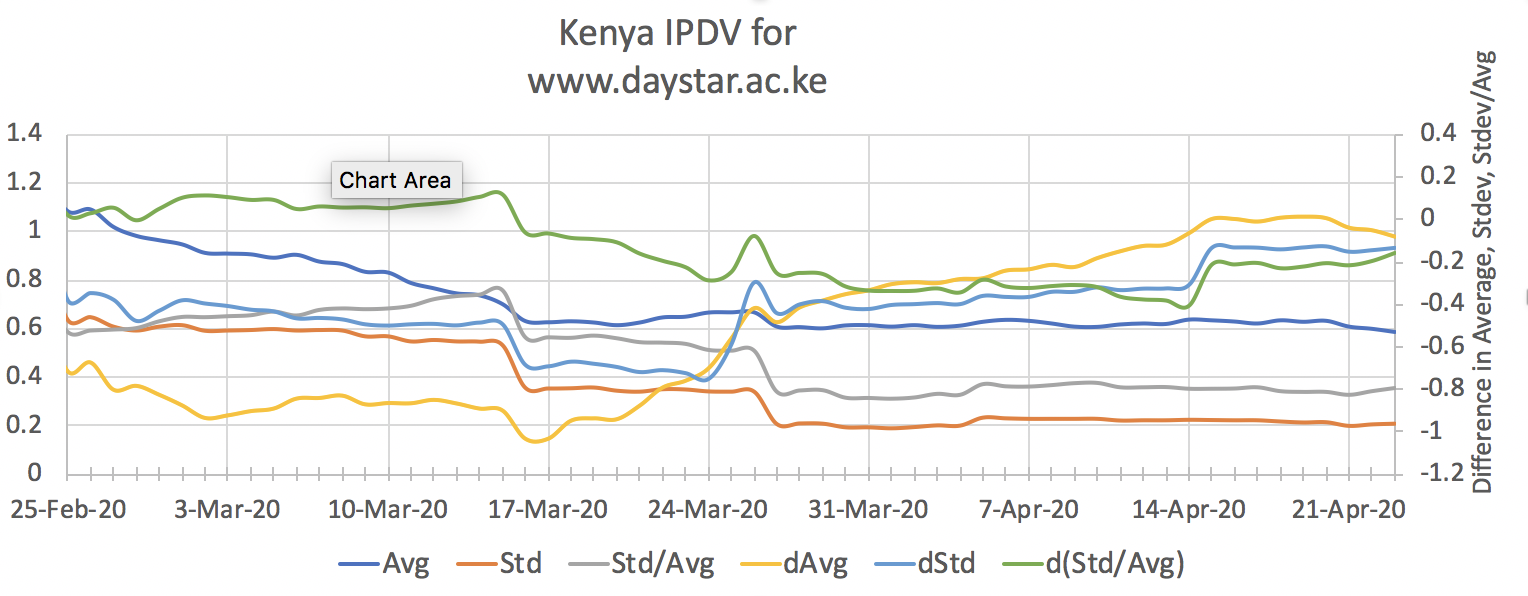Since there are too many overlapping curves we break the charts up by country. The spreadsheet can be found here.
Burundi
PingER monitors two hosts in Burundi. They are a government host www.assemblee.bi and the University of Burundi (www.ub.edu.bi). Neither appears to have marked changes around March-April. Also there is little information on interventions etc. in https://en.wikipedia.org/wiki/COVID-19_pandemic_in_Burundi
Ethiopia
There appears to be a sustained increase in IPDV in Ethiopia around Mar 16 when schools were closed and public gatherings were suspended. Looking in more detail at the 3 hosts monitored in Ethiopia there are 2 government hosts and a university. Below we see that all hosts had a sudden rise in IPDV between Mar 12 and Mar 15. See below and the Excel spreadsheet.
According to https://en.wikipedia.org/wiki/COVID-19_pandemic_in_Ethiopia#March_2020 the first Covid-9 case in Ethiopia was on Mar 13. "On 16 March 2020, the office of the Prime Minister announced that schools, sporting events, and public gatherings shall be suspended for 15 days."
Kenya
There are 3 hosts being monitored by PingER in Kenya. Two are government hosts and one (www.daystar.ac.ke) is Daystar University in Kampala. Looking at the chart of IPDV below it appears that IPDV dropped by several 10s of a percent sometime between Mar 21 and Mar 28. From https://en.wikipedia.org/wiki/COVID-19_pandemic_in_Kenya we see: On 15 March 2020, President Uhuru Kenyatta directed that the following measures to curb COVID-19 be implemented:
- "All schools and higher learning institutions be closed by Friday March 20, 2020.
- "Government and businesses people start working from home; except essential services.
- "No congressional meetings – weddings, malls, night clubs, churches, limitation of visits to hospitals.
- The Health Minister Mutahi Kagwe banned all social gatherings including religious gatherings on the same date.
- All bars were to remain closed from 22 March, with restaurants allowed to remain open for takeaway services only.
Looking at the averages, standard deviations, (standard deviation/averages) plus the derivatives of the averages, standard and (standard deviation/Average) for 30 days before and after each date, we get the chart below. It is seen that within about a week of the interventions the derivatives, in particular, took a sharp rise for all 3 hosts.
Malawi
PingER monitors three hosts in Malawi. They are the Parliament of Malawi (www.parliament.gov.mw), the Kamuza College of Nursing at theQueen Elizabeth Central Hospital, Blantyre (www.kcn.unima.mw) and the University of Malawi - Malawi Polytechnic (www.poly.ac.mw) in Blantyre.
From https://en.wikipedia.org/wiki/COVID-19_pandemic_in_Malawi the main interventions that might be expected to impact network utilization were:
- both public and private education institutions were closed from 23 March
- On 14 April, President Mutharika announced a 21-day lockdown starting Saturday 18 April at midnight.[17] However, on 17 April, the Malawi High Court temporarily barred the government from implementing the 21-day lockdown following a petition by the Human Rights Defenders Coalition
It is hard to discover any impact on the PingER IPDV performance from these measures.
Tanzania
PingER Monitors 4 hosts in Tanzania. Three are universities: the Open University of Tanzania, the Sokoine University of Agriculture (www.suanet.ac.tz), the State University of Zanzibar (www.suza.ac.tz). The other is related to education: the Tanzania Commission for Science and Technology (www.costech.or.tz). Of these only www.suza.ac.tz appears to notice any substantial change in responsiveness. In particular, there are big dips at weekends. Also the peaks before Mar 21 are larger than those after.
Looking at https://en.wikipedia.org/wiki/COVID-19_pandemic_in_Tanzania we find:
- On 17 March, the Prime Minister Kassim Majaliwa announced a range of measures, including closing schools. This corresponds nicely with the drop to near zero starting on Mar 18.
Uganda
PingER monitors two hosts in Uganda. One is the Victoria University in Kampala (www.vu.ac.ug), the other is a commercial host mail2.starcom.co.ug also in Kampala.
From https://en.wikipedia.org/wiki/COVID-19_pandemic_in_Uganda
On 18 March, public gatherings including places of worship, pubs, weddings, music shows, rallies and cultural meetings were suspended". Mar 22 1st case confirmed. On 25 March, public transport was suspended for 14 days. Only private cars with not more than three occupants are allowed on the road. On 25 March, public transport was suspended for 14 days. Only private cars with not more than three occupants are allowed on the road. On 26 March, police and other security personnel were heavily deployed in all city suburbs, slums and along the streets to enforce the president's directives. A few people who breached the government's restrictions were arrested. On 30 March, the President declared a nationwide curfew from 7 pm to 6:30 am, which would run for 14 days to prevent the spread of the disease.
These interventions appear to correlate with the rise in IPDV at the Victoria University.
Zimbabwe
PingER monitors two hosts in Zimbabwe. Hellenic school (https://www.hellenic.ac.zw/) and a commercial site www.paynet.co.zw
From https://en.wikipedia.org/wiki/COVID-19_pandemic_in_Zimbabwe we note the following interventions:
- On March 23, President Mnangagwa announced Closure of bars, nightclubs, movie houses, swimming pools, and sporting activities.
- On March 27 the government announced that the country would go into a nationwide lock down for 21 days from the 30 March onwards.
The chart below shows that towards the end of March the IPDV of both hosts drops and smoothes out. This appears to correlate with the interventions











